There’s nothing quite like the smell of freshly griddled sourdough English muffins, and these Bacon Cheddar Chive Sourdough English Muffins take that comfort to the next level.
Adapted from my popular classic sourdough English muffin recipe, this savory twist is loaded with crispy bacon, sharp cheddar, and fresh chives for a flavor that’s downright irresistible. Perfect for breakfast sandwiches, alongside a bowl of soup, or simply toasted with a smear of butter, these muffins bring a hearty, bakery-style touch to your kitchen while still being easy and approachable enough for a weekend bake at home.

What is an English Muffin?
An English muffin is a small, round, flat bread typically cooked on a griddle or skillet rather than baked. It’s known for its soft, chewy interior and signature golden-browned top and bottom, often dusted with cornmeal. When split open—ideally by hand or fork—it reveals a nooks-and-crannies texture that’s perfect for catching melted butter, jam, or eggs. Despite the name, they’re a staple breakfast bread in the U.S. and loved for their versatility.

Why I love this recipe
- It’s a fun and flavorful twist on classic sourdough English muffins.
- Perfect for breakfast sandwiches, toast-and-butter moments, or savory snacks any time of day.
- Freezer-friendly and perfect for meal prep or lazy weekend breakfasts.
- Adapted from my tried-and-true sourdough English muffin recipe.
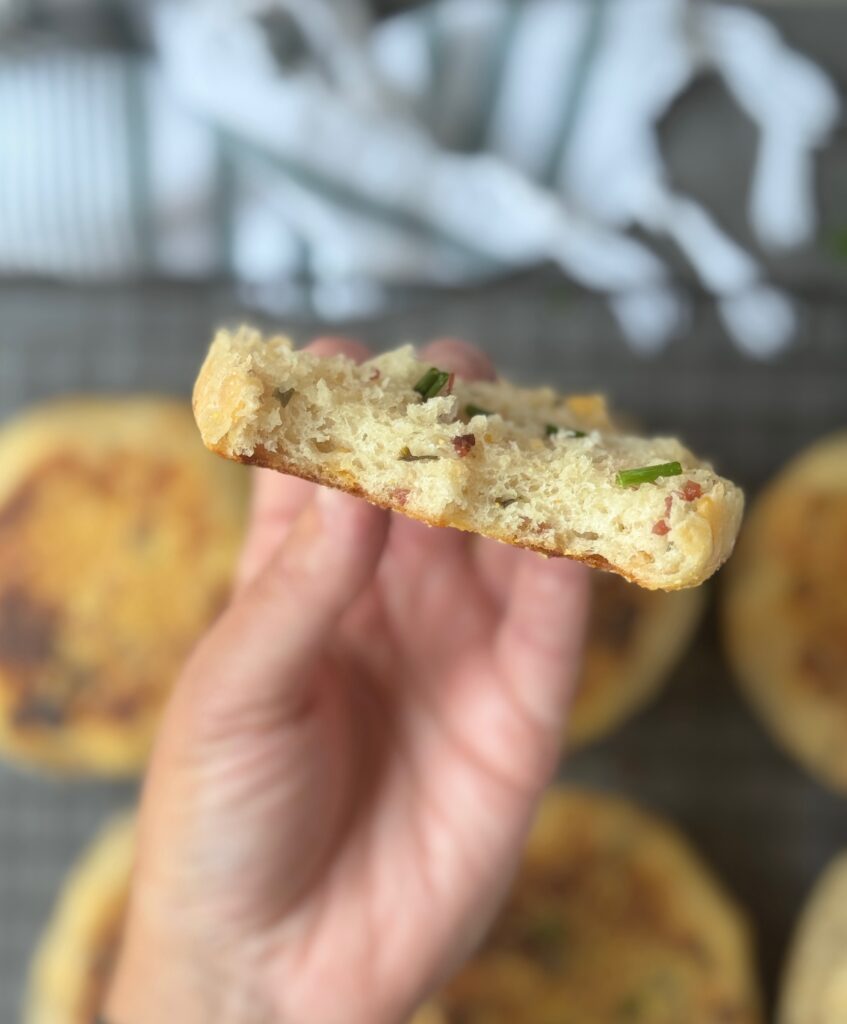
Troubleshooting: FAQ’s
Why is the center of my English muffin dense?
A dense middle usually means the dough was under-proofed. These muffins need to be light, puffy, and airy before they ever hit the skillet—if they still feel heavy or tight, let them rise longer.
Another culprit? Too much heat on the pan. If the outside cooks too quickly, the center won’t have time to fully set. Cook low and slow for even doneness.
My dough feels very sticky—what should I do?
This recipe is 73% hydration, so a slightly sticky dough is totally normal at first. After a few minutes of kneading or a couple stretch-and-folds, it will smooth out and become easier to work with. You can lightly flour your hands or the surface, but avoid adding too much flour—it’s meant to be a soft dough for that airy crumb.
Why didn’t my muffins puff up?
Make sure your levain is active and bubbly before mixing the dough. Also double check that you let them proof fully—if they haven’t visibly risen and feel light when handled, they’re not ready. A cold kitchen can slow things down, so be patient.
Why are my muffins flat?
If the muffins spread too much during the final proof, the dough may have been over-proofed or too warm. Try chilling them briefly before cooking to help hold their shape.
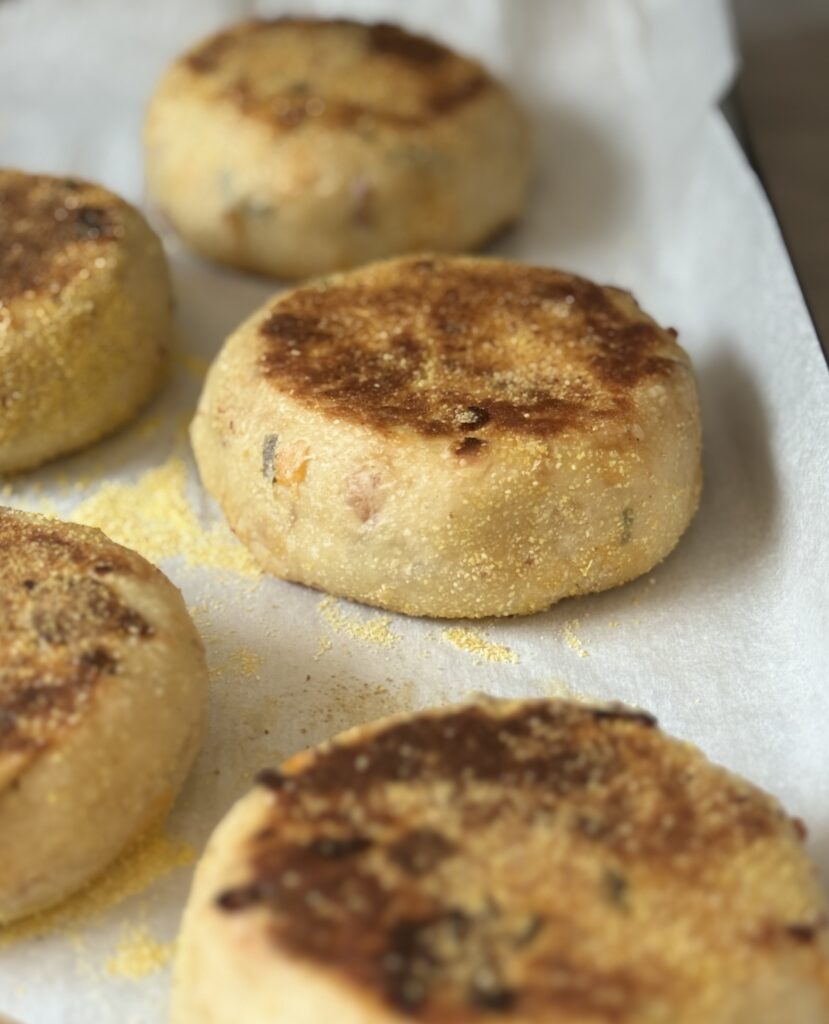
How to make bacon cheddar chive sourdough English muffins: step-by-step
Baker’s schedule: Make the sweet levain in the morning, mix the dough in the evening and allow it to rest overnight (8-10 hours) at room temp (68-70 degrees F). Shape the English muffins the following morning, allow to rest (3-5 hours) and bake.
Need more time? After the first rise, the sourdough English muffin dough can be refrigerated for up to 24 hours for added flexibility and flavor development.
Ingredients
For the sweet levain (optional)
- 15 grams active sourdough starter
- 15 grams honey or sugar
- 40 grams water (decrease to 30 grams if using honey)
- 40 grams flour (all-purpose or bread flour)
Do I have to use a sweet levain? No. A regular 100% hydration sourdough starter works perfectly. Just make sure it’s active, bubbly, and at its peak when you mix the dough. Keep in mind, it may produce a slightly more tangy flavor.
For the dough:
- 80 grams of sweet levain (from above)
- 290 grams milk
- 35 grams honey or sugar
- 55 grams avocado oil (melted unsalted butter can be used as well)
- 430 grams bread flour
- 9 grams salt
Inclusions:
- 85 grams cooked bacon (chopped and blotted to remove excess grease)
- 100 grams sharp cheddar cheese, shredded
- 20 grams chives (chopped)
For frying:
- 1/4 cup cornmeal for coating
- 1-2 tablespoons unsalted butter for frying
Can I use all-purpose flour instead of bread flour? Bread flour yields the best results, but if you’re using all-purpose flour, reduce the milk by 20 grams to account for lower absorption.
Equipment
- Food scale
- Mixing bowl
- Bench/dough scraper
- Large baking sheet
- Parchment paper
Instructions
Make the sweet levain
- In the morning mix together the sourdough starter, sugar (or honey if using), and water in a small jar until mostly dissolved. Then add the flour and mix until combined. Cover the jar loosely, and let it rest until doubled in size (6-8 hours).
Mix the dough
**The dough can be mixed by hand or a stand mixer
- In the evening, (once the levain has doubled in size), combine the levain, honey (or sugar if using), milk, and avocado oil (or melted butter if used). Stir to combine. Using cold milk is perfectly fine—it helps slow fermentation, making it ideal for a long overnight rise without the risk of overproofing.
- Next, add the flour and salt until a shaggy dough is formed. It will be sticky- this is normal. Cover the bowl and let the dough rest for 20 to 30 minutes
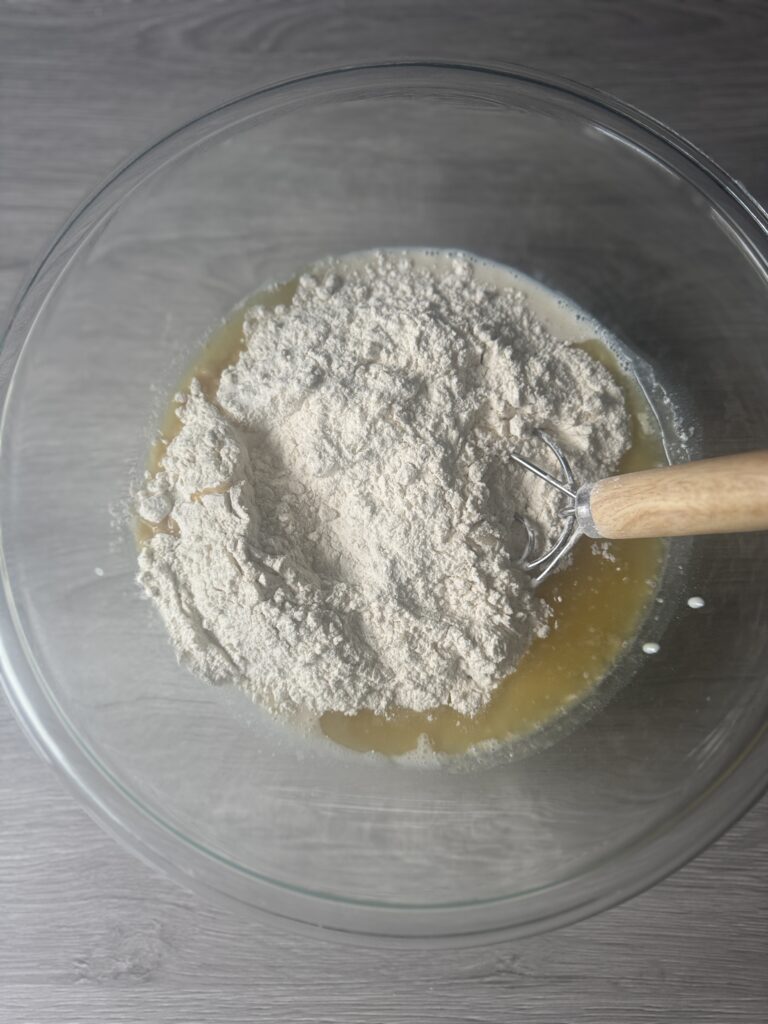
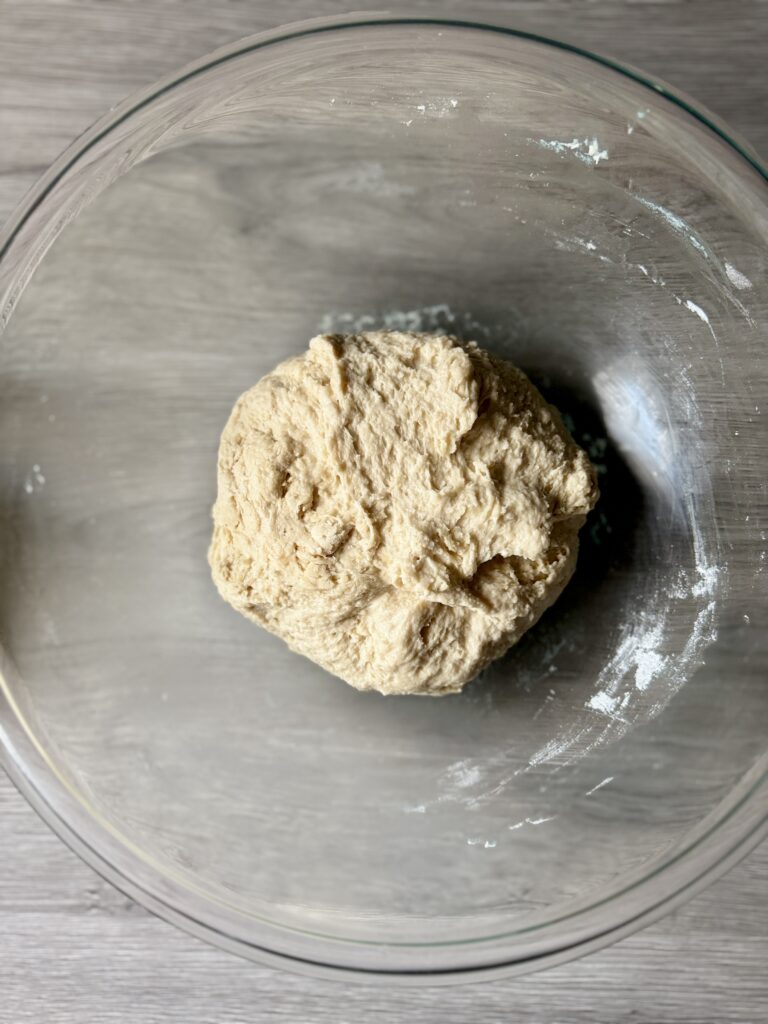
Add the inclusions and knead the dough
- After the dough has rested, begin incorporating the bacon, shredded cheddar cheese and chives by sprinkling a portion of it over the surface of the dough.
- Gently stretch one side of the dough upward, fold it over the mixture, and sprinkle on another handful of cheese and more seasoning.
- Rotate the bowl and repeat this process until all the bacon, cheddar, and chives are evenly distributed throughout the dough, being careful not to overwork it.




- Then, gently knead the dough in the bowl or on a lightly floured surface for a few minutes until the inclusions are evenly distributed and the dough comes together. Add a dusting of flour as needed if the dough feels too sticky.
Pro tip: The dough will feel sticky—and may become stickier as you knead. To avoid overworking it or adding too much flour, let the dough rest for 10–15 minutes. This allows the gluten to relax, making it much easier to finish kneading afterward.
- Once the dough has come together, is smoother, and slightly tacky cover it in a buttered bowl and let it rest for 20-30 minutes.
- Perform 1 stretch and fold to the dough after it has rested, cover it, and let it rest overnight (8-10 hours) at room temperature (68-73 degrees F).
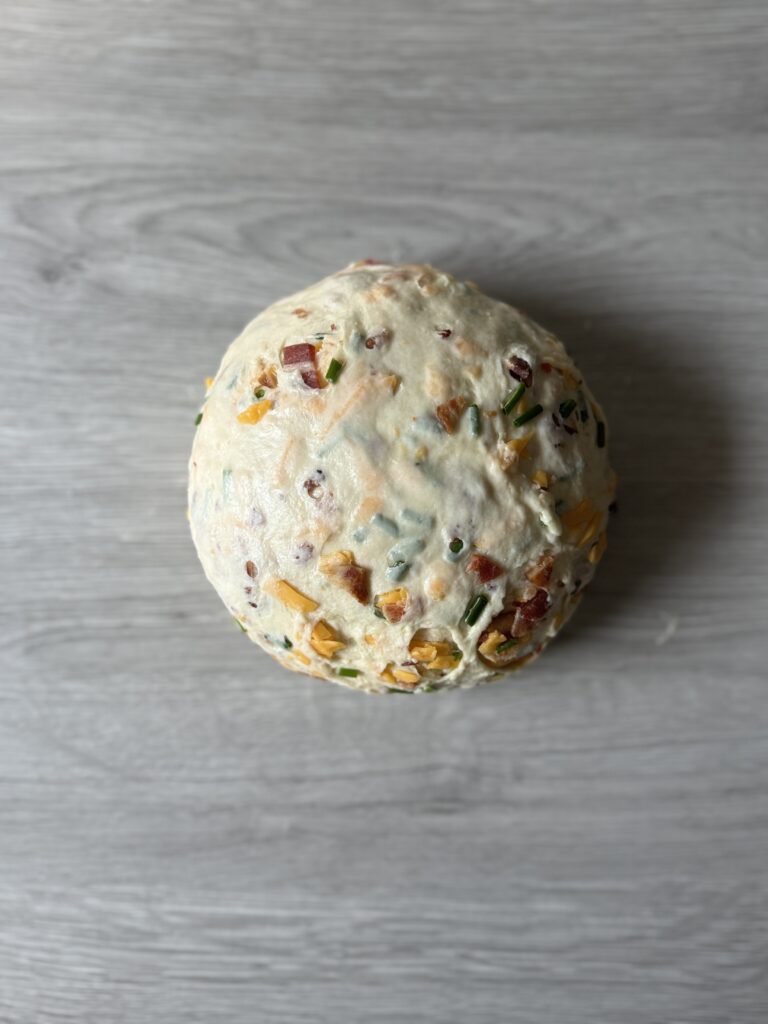
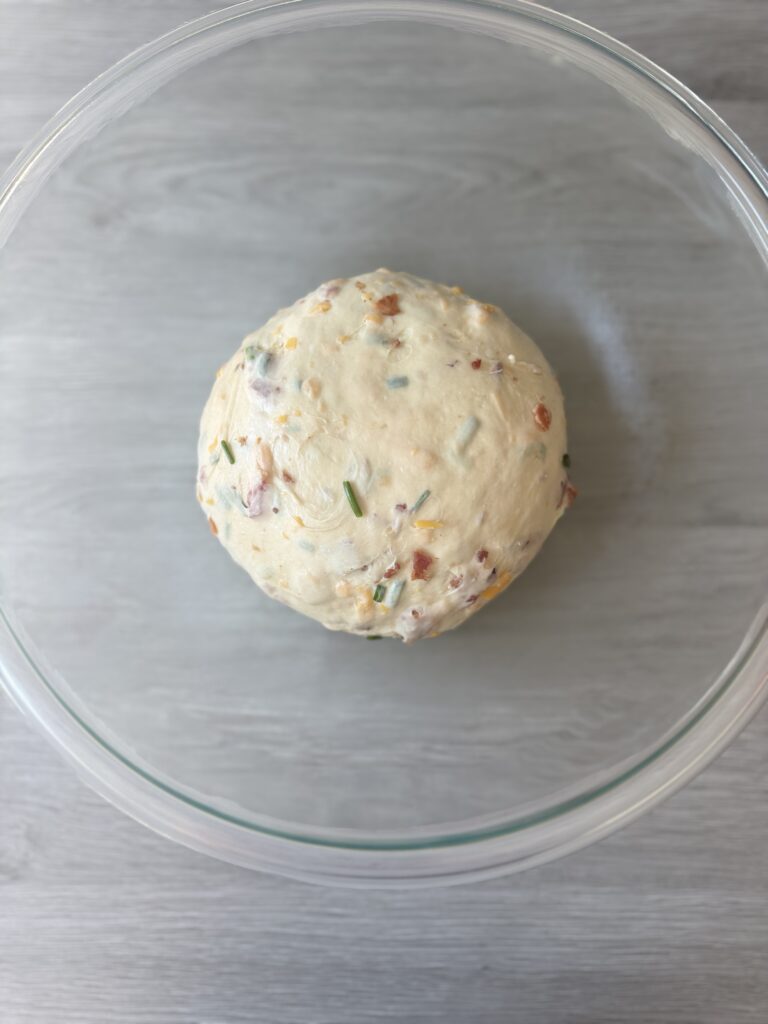
Shape the bacon cheddar chive sourdough English muffins
- By morning, the dough should look domed, puffy, and well-risen.

- Line a large baking sheet with parchment paper and generously sprinkle it with cornmeal. Also, prepare a separate plate with cornmeal for coating the dough rounds.
- Turn the dough out onto a lightly floured surface, weigh the dough and divide it into 10 equal pieces (about 90–100 grams each).

- Gently shape each piece into a smooth ball by tucking the seams underneath and pulling the dough toward you to create surface tension. It is normal for the dough to be a little sticky use flour to assist with this.
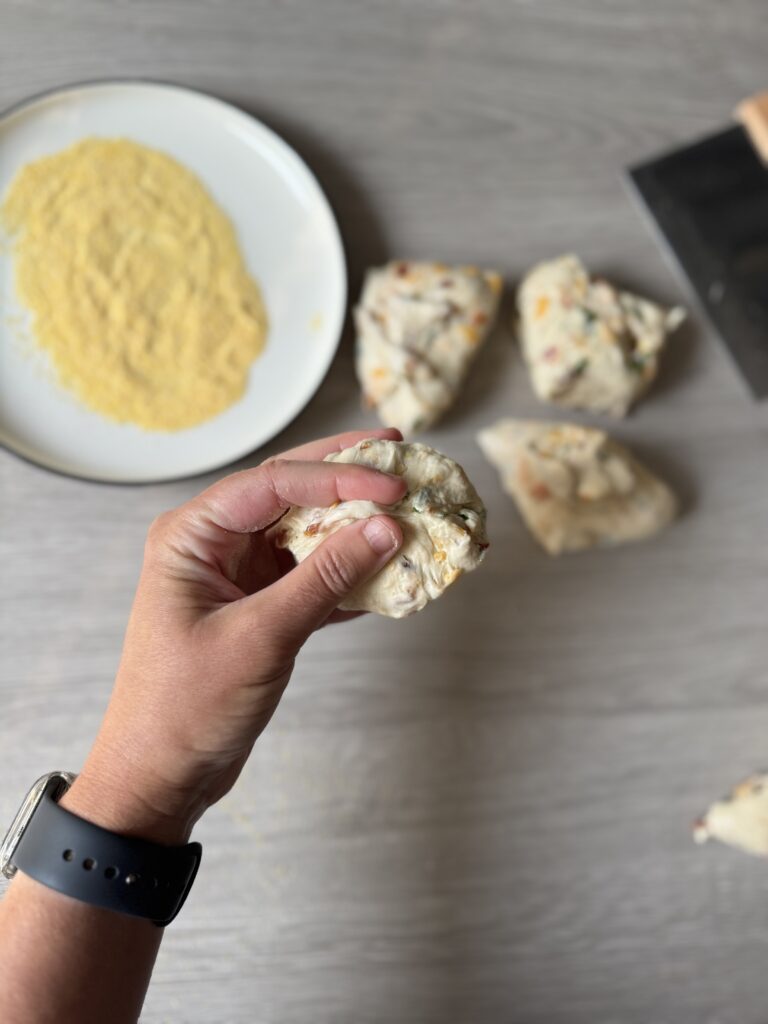
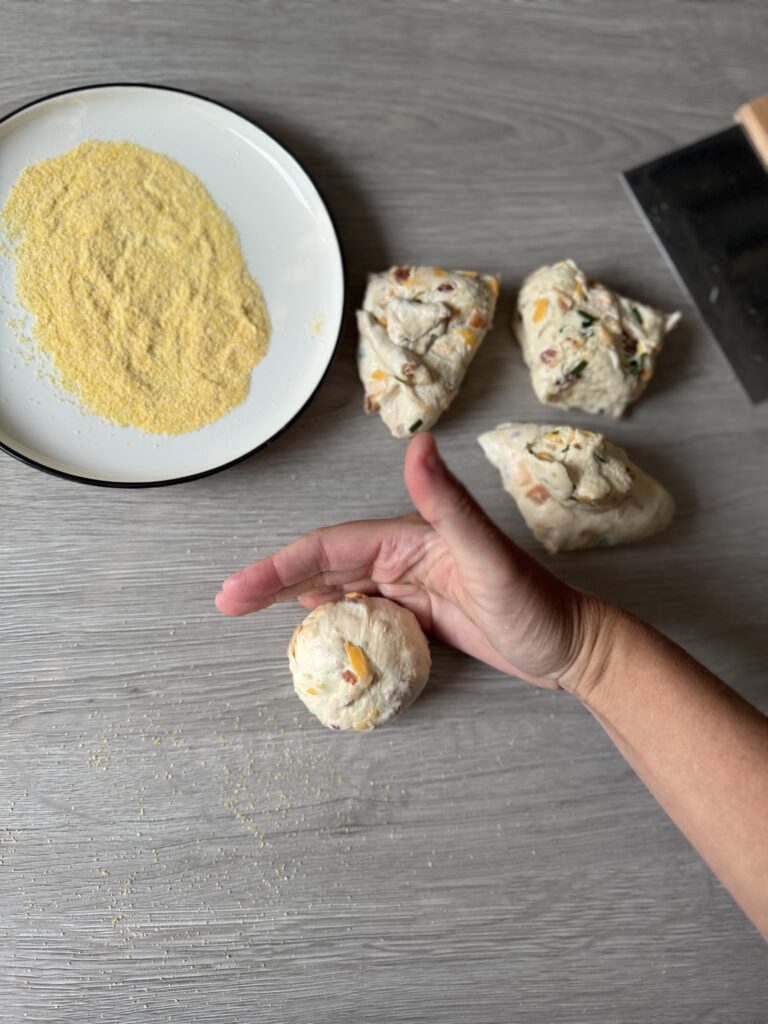
- Dip both sides in cornmeal and set the muffins on the parchment paper lined pan space slightly apart.
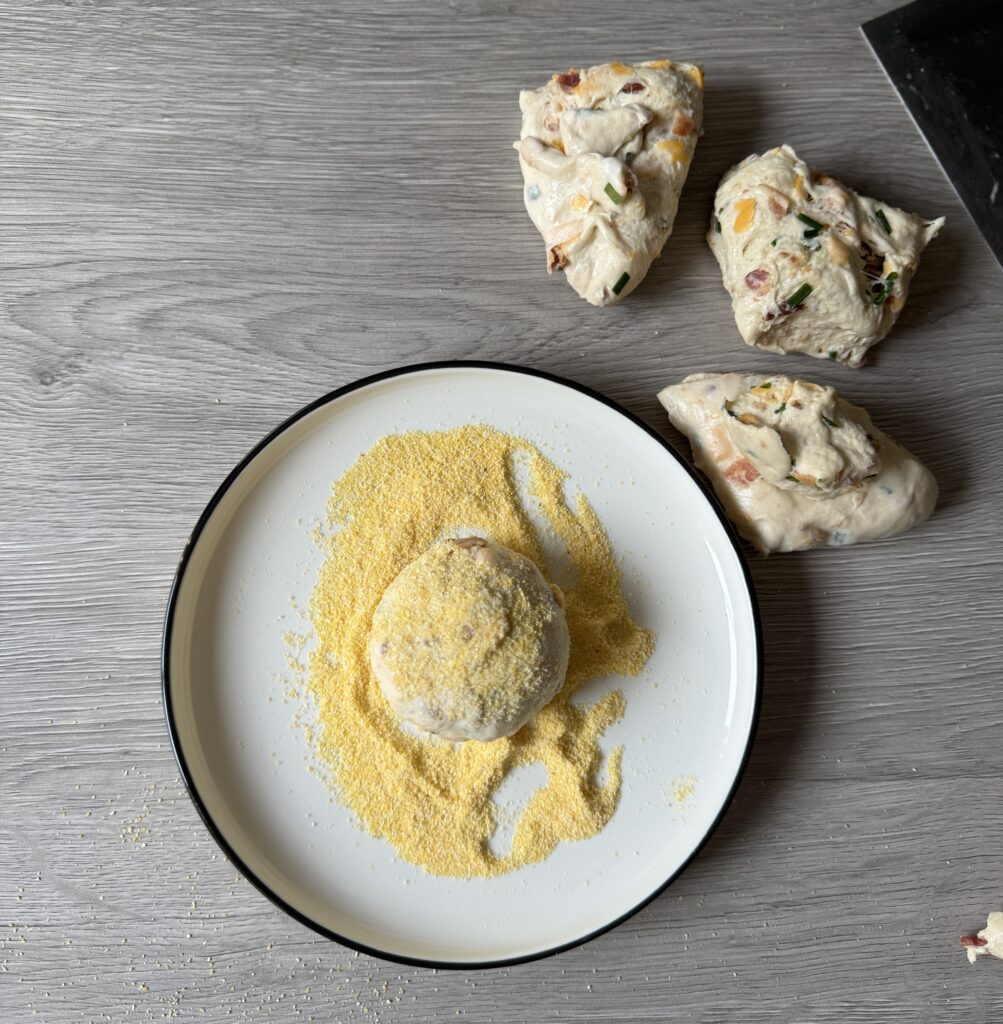
- Cover the dough with oiled plastic wrap or a dampened towel and let them rest until doubled in size (3-5 hours) depending on the temperature in your home.
I love using these proofing bags for covering my large baking trays!
- Pro tip: Place the tray in the oven with the light turned on for gentle warmth.
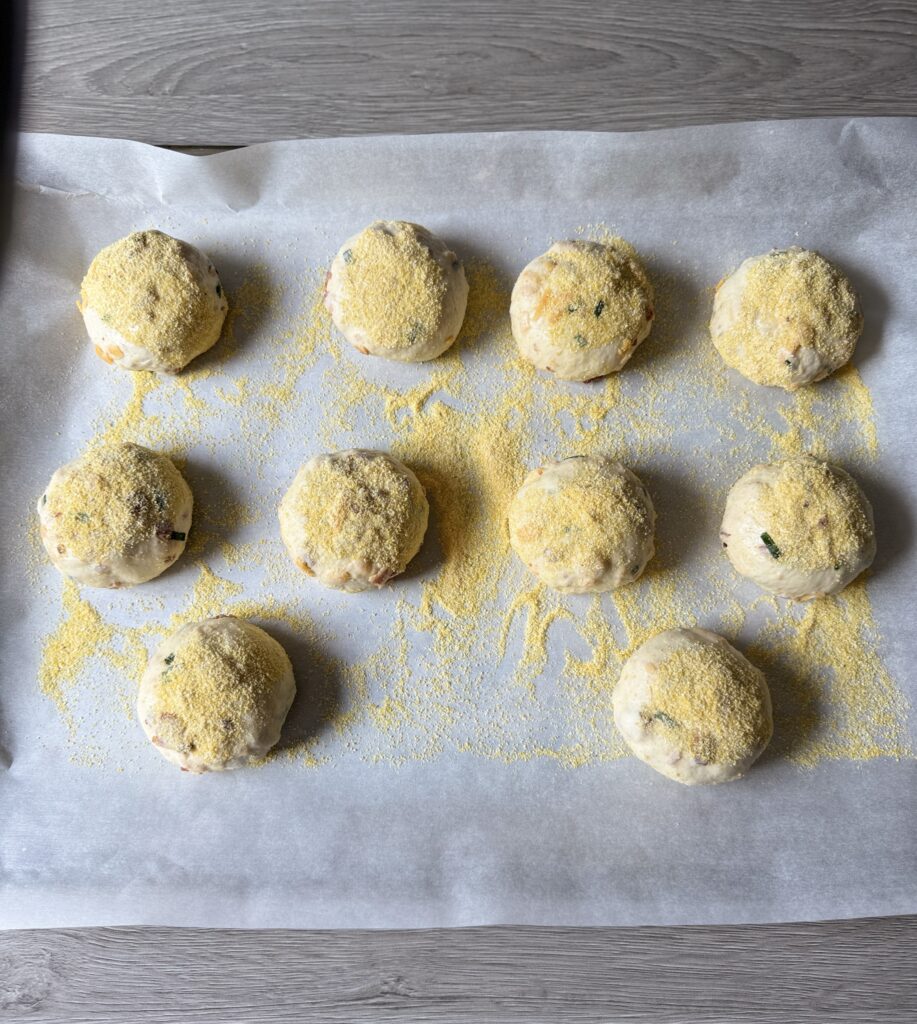
Bake the sourdough English muffins
- The sourdough English muffins are ready to be baked once they are doubled in size, airy, and puffy. They should be very light and delicate to the touch.

- Once the bacon cheddar chive sourdough English muffins have finished their second rise, preheat the oven to 350 degrees F. Heat a nonstick or cast iron skillet over low heat and add a tablespoon of butter.
- Working in batches of 3 or 4, gently transfer the muffins to the skillet (lightly oil a spatula for easy transferring) and cook for about 3 minutes on each side, or until lightly golden and set on the surface.

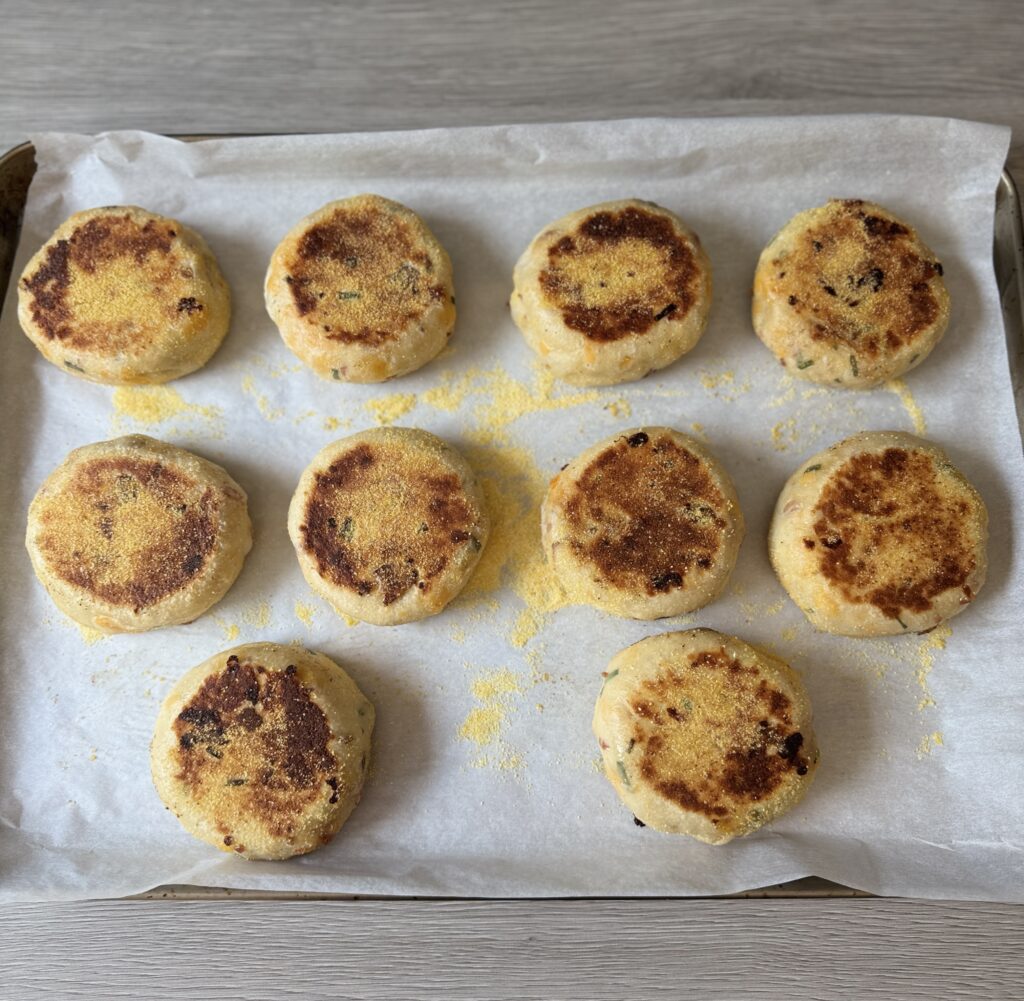
- Once the muffins are griddled, transfer them back to the parchment-lined sheet pan and bake for 12 to 15 minutes, or until fully cooked through. The internal temperature should reach 200–205°F (93–96°C) to ensure doneness.
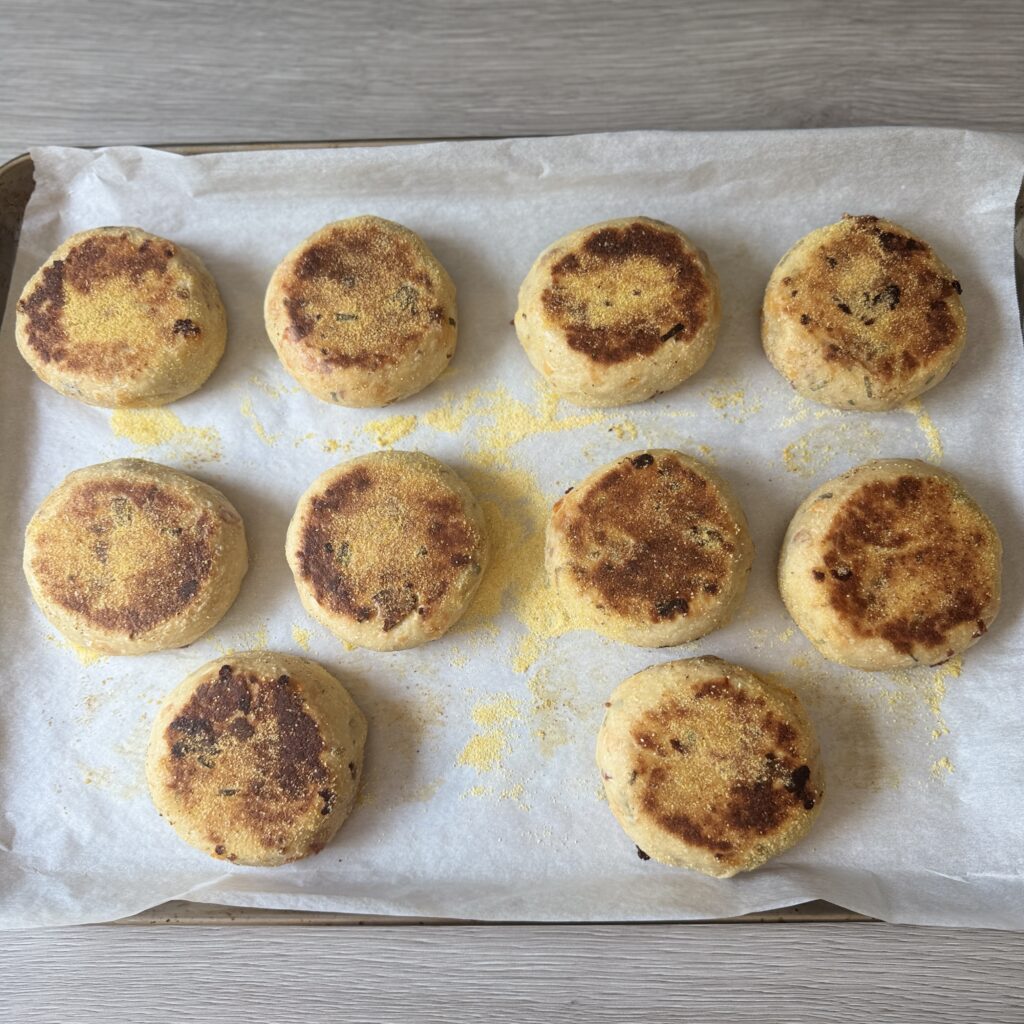
- Allow the sourdough English muffins to cool completely before splitting open with a fork to reveal the light, airy crumb. If you slice the English muffins while they’re still warm, the crumb may appear dense and gummy.
- Bacon cheddar chive sourdough English muffins toast up beautifully and are the perfect match for cream cheese, avocado, breakfast sandwiches, or a swipe of garlic herb butter!


Storage Instructions
- Allow bacon cheddar chive sourdough English muffins to cool completely before storing. For short-term storage, keep them in an airtight container at room temperature for up to 2 days.
- For the best long-term freshness, freeze the muffins in a zip-top bag or airtight container. To reheat, simply toast them straight from frozen. This preserves their texture and flavor beautifully, just like they were freshly made.

More sourdough English muffin recipes
- Sourdough English Muffins (overnight recipe!)
- Everything Bagel Sourdough English Muffins
- Cinnamon Raisin Sourdough English Muffins
Bacon Cheddar Chive Sourdough English Muffins
Equipment
- Food scale
- Mixing bowl
- Bench/dough scraper
- Large baking sheet
- Parchment paper
Ingredients
For the sweet levain (optional)
- 15 grams active sourdough starter bubbly & at peak
- 15 grams honey or sugar
- 40 grams water decrease to 30 grams if using honey
- 40 grams all-purpose or bread flour
For the dough
- 80 grams sweet levain from above
- 290 grams whole milk
- 35 grams honey or sugar
- 55 grams avocado oil or melted unsalted butter
- 430 grams bread flour
- 9 grams salt
For the inclusions
- 85 grams cooked bacon chopped & blotted dry
- 100 grams sharp cheddar cheese shredded
- 20 grams chives chopped
For frying
- 1/4 cup cornmeal
- 1-2 tablespoons butter for frying
Instructions
Make the sweet leavin
- In the morning mix together the sourdough starter, sugar (or honey if using), and water in a small jar until mostly dissolved. Then add the flour and mix until combined. Cover the jar loosely, and let it rest until doubled in size (6-8 hours).
Mix the dough
- **The dough can be mixed by hand or a stand mixerIn the evening, (once the levain has doubled in size), combine the levain, honey (or sugar if using), milk, and avocado oil (or melted butter if used). Stir to combine. Using cold milk is perfectly fine—it helps slow fermentation, making it ideal for a long overnight rise without the risk of overproofing.
- Next, add the flour and salt until a shaggy dough is formed. It will be sticky- this is normal. Cover the bowl and let the dough rest for 20 to 30 minutes
Add the inclusions and knead the dough
- After the dough has rested, begin incorporating the bacon, shredded cheddar cheese and chives by sprinkling a portion of it over the surface of the dough.
- Gently stretch one side of the dough upward, fold it over the mixture, and sprinkle on another handful of cheese and more seasoning.
- Rotate the bowl and repeat this process until all the bacon, cheddar, and chives are evenly distributed throughout the dough, being careful not to overwork it.
- Then, gently knead the dough in the bowl or on a lightly floured surface for a few minutes until the inclusions are evenly distributed and the dough comes together. Add a dusting of flour as needed if the dough feels too sticky.Pro tip: The dough will feel sticky—and may become stickier as you knead. To avoid overworking it or adding too much flour, let the dough rest for 10–15 minutes. This allows the gluten to relax, making it much easier to finish kneading afterward.
- Once the dough has come together, is smoother, and slightly tacky cover it in a buttered bowl and let it rest for 20-30 minutes.
- Perform 1 stretch and fold to the dough after it has rested, cover it, and let it rest overnight (8-10 hours) at room temperature (68-73 degrees F).
Shape the bacon cheddar chive sourdough English muffins
- By morning, the dough should look domed, puffy, and well-risen.
- Line a large baking sheet with parchment paper and generously sprinkle it with cornmeal. Also, prepare a separate plate with cornmeal for coating the dough rounds.
- Turn the dough out onto a lightly floured surface, weigh the dough and divide it into 10 equal pieces (about 90–100 grams each).
- Gently shape each piece into a smooth ball by tucking the seams underneath and pulling the dough toward you to create surface tension. It is normal for the dough to be a little sticky use flour to assist with this.
- Dip both sides in cornmeal and set the muffins on the parchment paper lined pan space slightly apart.
- Cover the dough with oiled plastic wrap or a dampened towel and let them rest until doubled in size (3-5 hours) depending on the temperature in your home.Pro tip: Place the tray in the oven with the light turned on for gentle warmth.
Bake the sourdough English muffins
- The sourdough English muffins are ready to be baked once they are doubled in size, airy, and puffy. They should be very light and delicate to the touch.
- Once the bacon cheddar chive sourdough English muffins have finished their second rise, preheat the oven to 350 degrees F. Heat a nonstick or cast iron skillet over low heat and add a tablespoon of butter.
- Working in batches of 3 or 4, gently transfer the muffins to the skillet (lightly oil a spatula for easy transferring) and cook for about 3 minutes on each side, or until lightly golden and set on the surface.
- Once the muffins are griddled, transfer them back to the parchment-lined sheet pan and bake for 12 to 15 minutes, or until fully cooked through. The internal temperature should reach 200–205°F (93–96°C) to ensure doneness.
- Allow the sourdough English muffins to cool completely before splitting open with a fork to reveal the light, airy crumb. If you slice the English muffins while they’re still warm, the crumb may appear dense and gummy.
- Bacon cheddar chive sourdough English muffins toast up beautifully and are the perfect match for cream cheese, avocado, breakfast sandwiches, or a swipe of garlic herb butter!
Storage Instructions
- Allow bacon cheddar chive sourdough English muffins to cool completely before storing. For short-term storage, keep them in an airtight container at room temperature for up to 2 days.
- For the best long-term freshness, freeze the muffins in a zip-top bag or airtight container. To reheat, simply toast them straight from frozen. This preserves their texture and flavor beautifully, just like they were freshly made.


Leave a Comment & Rate the Recipe